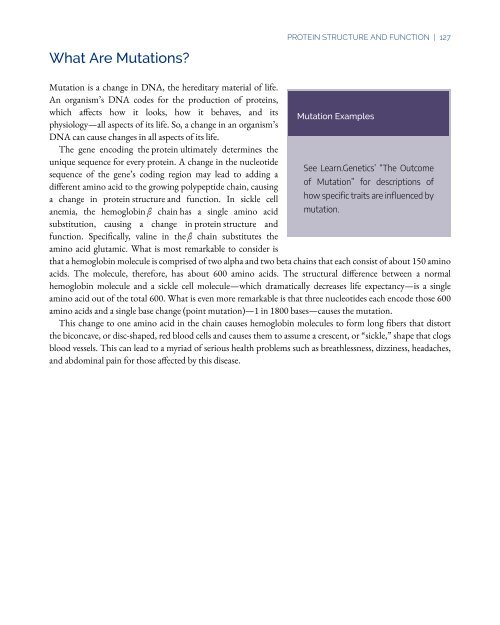An Interactive Introduction to Organismal and Molecular Biology, 2021
An Interactive Introduction to Organismal and Molecular Biology, 2021
An Interactive Introduction to Organismal and Molecular Biology, 2021
You also want an ePaper? Increase the reach of your titles
YUMPU automatically turns print PDFs into web optimized ePapers that Google loves.
What Are Mutations?<br />
PROTEIN STRUCTURE AND FUNCTION | 127<br />
Mutation is a change in DNA, the hereditary material of life.<br />
<strong>An</strong> organism’s DNA codes for the production of proteins,<br />
which affects how it looks, how it behaves, <strong>and</strong> its<br />
Mutation Examples<br />
physiology—all aspects of its life. So, a change in an organism’s<br />
DNA can cause changes in all aspects of its life.<br />
The gene encoding the protein ultimately determines the<br />
unique sequence for every protein. A change in the nucleotide<br />
See Learn.Genetics’ “The Outcome<br />
sequence of the gene’s coding region may lead <strong>to</strong> adding a<br />
of Mutation” for descriptions of<br />
different amino acid <strong>to</strong> the growing polypeptide chain, causing<br />
a change in protein structure <strong>and</strong> function. In sickle cell how specific traits are influenced by<br />
anemia, the hemoglobin β chain has a single amino acid mutation.<br />
substitution, causing a change in protein structure <strong>and</strong><br />
function. Specifically, valine in the β chain substitutes the<br />
amino acid glutamic. What is most remarkable <strong>to</strong> consider is<br />
that a hemoglobin molecule is comprised of two alpha <strong>and</strong> two beta chains that each consist of about 150 amino<br />
acids. The molecule, therefore, has about 600 amino acids. The structural difference between a normal<br />
hemoglobin molecule <strong>and</strong> a sickle cell molecule—which dramatically decreases life expectancy—is a single<br />
amino acid out of the <strong>to</strong>tal 600. What is even more remarkable is that three nucleotides each encode those 600<br />
amino acids <strong>and</strong> a single base change (point mutation)—1 in 1800 bases—causes the mutation.<br />
This change <strong>to</strong> one amino acid in the chain causes hemoglobin molecules <strong>to</strong> form long fibers that dis<strong>to</strong>rt<br />
the biconcave, or disc-shaped, red blood cells <strong>and</strong> causes them <strong>to</strong> assume a crescent, or “sickle,” shape that clogs<br />
blood vessels. This can lead <strong>to</strong> a myriad of serious health problems such as breathlessness, dizziness, headaches,<br />
<strong>and</strong> abdominal pain for those affected by this disease.


















